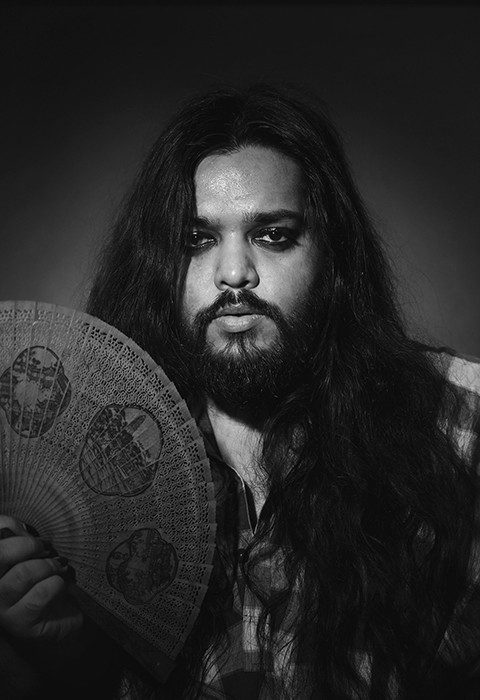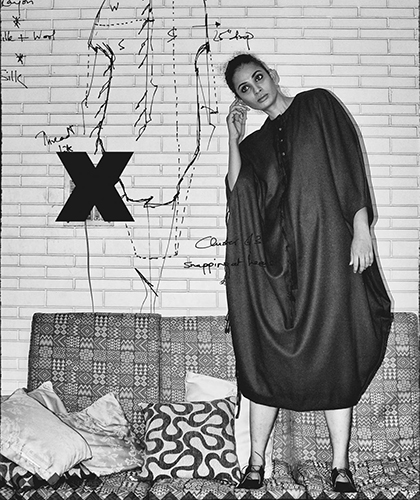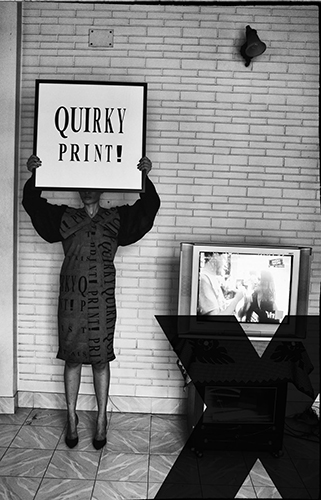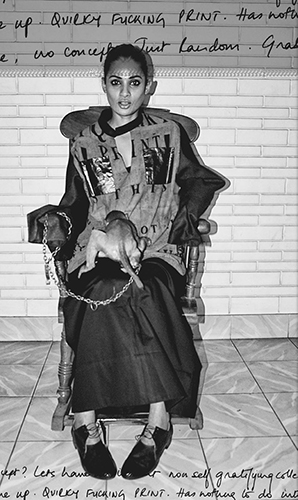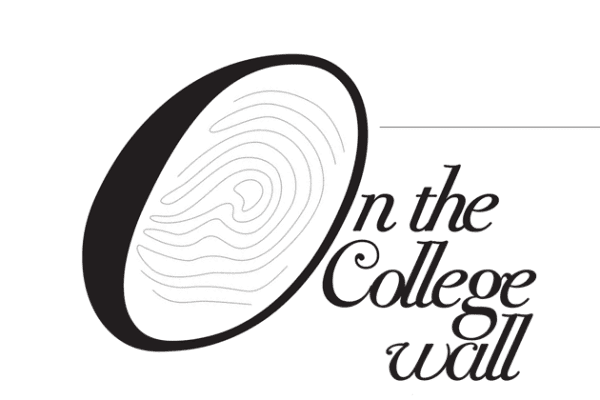By choosing not to present his line at Fashion Week last season and opting instead for an intimate showcase, you wonder what’s playing on the mind of Kallol Datta. Humour, satire, social commentary, eschewing stereotypes and trends or debunking notions? An interview with Nidhi Dugar Kundalia.
Your sexually charged digital art prints exhibited in Delhi last month questioned gender roles in society? Do they have a political and sociological message?
These prints were part of the 2013 Catalogue. I did an art print catalogue. Selection of this was displayed at the United Art Fair in Delhi. Amongst this was the Textbook Series. Essentially, they was the text books we used in school. But the covers have been replaced by stick figures performing sexual acts which are considered deviant even today. And it wasn’t sexuality in terms of gay, straight, bi, trans etc; But it was more to do with the fact that everyone does it but is still considered deviant. So these blasphemous stick figures were used more as a tool to get everyone’s attention and also, to talk about the inequalities around us. And it’s a fact. I have female colleagues who have tried to push the boundaries in fashion. But it’s not taken as well when a male designer does the same. And considering that we like to imagine that we are a part of the industry that is open to cutting edge ideas, it’s a shocker. When the prints were put up in Delhi, I got great feedback from the art industry. From the fashion industry, it was the same thing all over again. People felt that it was just for attracting attention.
In India, the fashion industry does not have too many references and contexts they can rely on. So everything happens to be an immediate reaction from them. I got to see that for my prints as well.
Why take these prints out now?
I just felt it was very current, very topical. I haven’t released a lot of the prints for public display yet. But those which I did, it helped form a nice story which was relevant to what’s going on around us. Rapes have been happening forever. But when you have atrocities being reported in bulk, literally in bulk, the questions become relevant. All my friends abroad think India is such an unsafe place to be. Even the men. That’s such a skewed perception of a country. It’s like that perception that existed a while back that you’d get diarrhoea if you drank water in India. While all this is happening, there is still some dialogue happening at the same time. It’s not just protest for the sake of it. Even if I’m not on the streets, I’m still adding to the cause…
I remember reading about your inspiration for last year’s autumn winter grotesque collection…
That was spring summer 13. The collection was called grotesque nonsense. It was more to do with how when eastern concepts travel to the west, they get lost in translation.
Because of which I think there are so many stereotypes and clichés surrounding what happens in our part of the world. We tied a storyline in the collection to the Japanese concept of Ero guru. For instance, suicide is Japan can be very ritualistic. A mother will help a daughter sharpen her knives, have a proper tea ceremony so that she can have an efficient suicide setting ritualistic tones. That really fascinated me. We were working with the body. So I took a femur and tibia, fused them together, enlarged them to form chevron prints running the height and breadth of the garment. So when I was talking about eastern concepts getting lost in the west, I was actually talking about how they think we are just a place for consumption. It’s just the sari that we have. We have a handful of great designers who are doing very good things in terms of technicalities like pattern cutting and draping. This was to prove that it wasn’t just a place for consumption but production and creation as well.
What about the psychotic lady who ran about cutting people? Who is she?
She was this psychotic lady who was created in my head. She has been performing autopsies in some collections of mine. In other collections, she has moved over to Japan and helps people commit suicide. This lady enjoying ritualistic fervour is what triggered my imagination. I remember in London where I used to study, that time it was all about this concert pianist who wakes up to find himself turned into a circus freak. His body becomes grotesque. There are lumps and bumps all over his body. He becomes a carnival folk. That’s where it all began. You see, most of my garments do not have a proportion. There are sudden bulges happening. There are three dimensional folds. I don’t cut linearly and that’s why I use more of circular patterns, even to form something that’s lean as well. That’s where I’m trying to hone my technique and craft as well. This aspect of garment making challenges me.
I’ve always felt that when we talk about trends, ‘What’s in’ etc that’s the biggest chutiyap in the world. Because what are trends? It’s formulated by some emotionally vapid corporations and these scamming forecasting agencies and some random designer who says lets call this particular thing a trend. Let’s coin this word so that we can sell things more. Things that trend and this booking list, where they say that we are already booked up, that’s just crap!
How hard has it been to make Indians understand this deconstructed, unconventional structure, form and shapes?
Not very easy. When they see something on the hanger that’s bulky or anti fit, they don’t pick it up. They don’t realise if it’s cut well, it won’t add bulk to your body. I’m still trying to convince people and stores that my garments won’t necessarily make you fat. I think this is because the way I was brought up. I grew up in the Middle East where men, women and children all wear the same garment; a billowing robe like silhouette. Be it the burqa, the robe or what have you. This was everywhere I moved with my parents – Abu Dhabi, Dubai, Manama in Bahrain. I like my women covered up. That’s just my aesthetic. I like them covered from neck to toe. I always give my girl flat shoes on the runaway. And that’s why it’s such a kick for me to see women who buy my clothes. Wearing them in a way I would have never imagined. With bondage heels and designer bags. Or just trousers passed off as a dress.
Women’s fashion tends to get a lot more focus than men’s fashion. And women tend to spend a lot more money on clothes and accessories. Is this because women are targeted and exploited in a certain way, as many feminists have said? Or are women inherently drawn to these things more than men?
Actually, according to statistics, men spend a lot more money on clothing than women. So men’s clothes sell more. Women just have a lot more options. There is so much more I can do with a dress. Men aren’t ready to experiment. But with luxury market all over the world, men prescribe to certain subcultures or have an alternative lifestyle. But with women, if someone is wearing a bondage dress, they see someone wearing an anti-fit; suddenly they’d convince themselves to wear anti-fit too.
Also, men as designers tend to get attracted to their muse. Or their notions of beauty. And more often than not, they happen to be the female form rather than the male form. And that’s why men are used mostly as eye candy in ad campaigns. But on runaway where it actually matters, it’s the female model who rules.
Men’s fashion has always had an element of power. But women’s fashion has always been about attractiveness, or sexual attractiveness for that matter. Your comments on that…
Look back at history. Men started wearing heels before women. If you look at the pictures of Louis the Fifteenth, they used to wear more heels, more make-up and more wigs than women. If you see pictures from the North West Frontier Province and Rajasthan, there was a time when they would wear more oversized shalwars and patialas, they would wear more jewellery than their women would. They had piercings on their faces too. Nose, eyebrows, ears. All this comes to the basic facts of attracting a potential mate. So men would wear stocking and high heels to attract more mates. Also, it has to do with conditioning, over a period of time. If there is a woman who did not want to shave her arm pits and wear sleeveless, she was looked at with derision. But if a man wants to do the same, he would be passed off saying he is just a man. I don’t understand all this. It doesn’t go with my theory. So when I created my line for men, I didn’t introduce it as a men’s wear collection. Nor did I call it unisex. Because that implies both genders can wear it. For me it was asexual. It does not matter what gender you are. If you like a garment, wear it. It depends on what you want to attract. Your reflection in the mirror or someone at a nightclub or restaurant. Only if you can attract yourself, do you feel good wearing it.
Fashion seems to always have this patriarchal message. It is a patriarchal society that dictates what “womanhood” is and what limits it has to confine itself to? The amount of deconstruction you play with… do you use fashion as sneaky device to resist control or domination?
When you have colleges giving decrees like you have to wear salwar to college or you have to wear a headscarf if you are in certain schools, it is all religion based. And religion has been propagated by man. None of our holy books were handed over to us by God. So essentially, it’s men who have always dictated what one should wear. They have used religion as a tool and it percolates down to every single aspect of our lives…which is happening a lot with clothing now a days. So for me it’s less a rebellion or making a statement. It’s more of that there is this option that you can wear other clothes. You have an option to wear something interesting and not succumb to social pressures, what people expect you to wear or the way they expect you to dress. All these designers with this stupid theory about this strong global confident woman, who the f#*k is she? I’ve never met her. I love all women. Anybody who enjoys wearing clothes. Nobody is going to wear my garment and say ‘I’m feeling sexy in a Kallol Datta.’ But I’m sure they can be like, ‘I feel really cooler.’ My clothes are for people like that. Men or women who don’t rely on their femininity or masculinity as their only tool of making a statement.
Even if fashion is not used overtly as a tool of “resistance”, do you see it as a powerful means of self-expression?
It is. At the end of the day, everyone is showing clothes abroad. It is an exciting time. They have the power retail sector. A big help is the new age social media. So for me it’s like India is being shaped aesthetically and am glad I’m playing a part in it. I can’t separate my professional and personal life. I put in a lot of emotions in my clothes regardless of silly trends predicted by these so called forecasters. I put personal in everything. That’s the only way I know how to operate. It’s been crazy. After this one show, I had two women who claimed that they were crying during my show. I didn’t believe them. But after the show when I watch my show’s video recordings, I’m like f#*k…they are actually crying. Because they were really sad and they thought that I’m coming from a sad place. The emotions were misplaced though. I was really angry when I did that collection, not sad. But at least I’ve been able to illicit a response. An emotional response and that is so necessary for me. So people have been either getting off or they are getting angry. That is the only way to engage in a dialogue. We don’t have a dialogue on fashion in India. For artists who do paintings, they have curatorial hubs; they have residences and all of that. We don’t have that in India yet. We are still seen as an entertainment industry. I still pay entertainment taxes for my show. That’s really sad.
If so, doesn’t the idea of a “current style” or “trends” dictated by a fashion industry go against that idea of an individual’s own self-expression?
I’ve always felt that when we talk about trends, ‘What’s in’ etc that’s the biggest chutiyap in the world. Because what are trends? It’s formulated by some emotionally vapid corporations and these scamming forecasting agencies and some random designer who says lets call this particular thing a trend. Let’s coin this word so that we can sell things more. Things that trend and this booking list, where they say that we are already booked up, that’s just crap! That means you are dictating what people should or should not wear or have in their wardrobes. While I feel fashion should be democratic. There should be some form of police controlling but you are free to choose what you want to wear. I’m not going to say oversized silhouettes are in fashion to push my product. I positively hate the word trends. Every time I get a call from these dailies asking me ‘Pujo’r fashion ki?’… I say f#$k off! I don’t want to tell you what to wear for this season.’
You have a very distinctive androgynous style of dressing yourself? How does it define your personality and politics?
Now I have sobered down a lot. Because I realised even within the fashion industry, people weren’t taking me seriously if I was the way I was. I used to have pink hair, green hair. Id be wearing grandfather’s lungis with huge glasses and everything. I used to enjoy f#$king around with peoples’ minds who think this is what a man should be like or this is what a designer should be like. I’d give two hoots. Because my parents have never put any sort of pressure on me. If they don’t, why should any other fathers have a problem with it? That used to piss me off a lot before. They’d talk a lot more about me than my work. So I took a few measures for that. I didn’t come out on the runaway. I used to peep or wave a hand from behind the curtains. I skipped all my post show interviews. The same stupid questions. ‘Apka inspiration kya tha…?’ ‘Apne showstopper use nahi kiya?’ I don’t hire a PR. The best way, I think, for any voice is to grow organically. In this day and age, everyone has an instagram and twitter where anyone can become famous based on how they portray their worlds. I took it upon myself that I should do the same thing but I curate pictures and words before putting them up. To create an ecosystem of sorts, reaching out to people who are like minded and open minded enough to understand and accept new ideas. That’s what will help us evolve and move forward.

